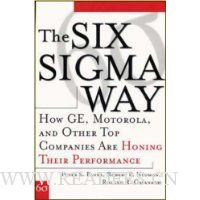
基本信息出版社:McGraw-Hill Professional
页码:448 页
出版日期:2000年04月
ISBN:0071358064
条形码:9780071358064
版本:1
装帧:精装
外文书名:六西格玛之道
内容简介 在线阅读本书
Six Sigma is a system for improving the quality of organizational processes. It was originally developed at Motorola in the 1980's and has become one of the most widely discussed and reported trends in business over the past two years, thanks largely to the phenomenal successes of the Six Sigma program at one of the world's most successful companies, GE. GE CEO Jack Welch, has been preaching about and implementing the Six Sigma philosophy throughout GE, and credits the program with millions of dollars in annual cost savings and product quality improvements.
作者简介 Peter S. Pande is Founder and President of Pivotal Resources, an international consulting firm providing Six Sigma implementation, training, and management development services in industries from financial services to high technology. Robert P. Neuman, Ph.D., is a senior Consultant with Pivotal Resources. He is a noted speaker in business improvement methods and Six Sigma. Roland R. Cavanagh, P.E., is a professional engineer and Pivotal Resources Consultant with Pivotal Resources. His areas of expertise include process measurement and applied statistics, business reorganization, and Six Sigma methods.
编辑推荐 Amazon.co.uk Review
Six Sigma is a data-driven management system with near-perfect performance objectives that has been employed to notable acclaim at leading corporations like General Electric. Its name is derived from the eye-catching statistical target of operating with no more than 3.4 defects per one million chances, but Peter Pande, Robert Neuman and Roland Cavanagh--associates in a firm providing Six Sigma implementation, training and management development services--contend its principles can be applied in businesses of all types to routinely reduce costs, improve productivity, increase market share, and achieve other positive results. The Six Sigma Way is their comprehensive self-help guide to adapting and using the system under various conditions. Its first two parts cover fundamentals and provide specific suggestions for aligning the process with individual needs and goals. (These include sections on balancing potential costs and benefits, clarifying objectives, and defining timeframes.) The final part, which comprises more than half the book, focuses on implementation through a detailed yet flexible five-step "roadmap" tied to a company's core processes, key customers, current performances, "high-potential improvement opportunities", and future practices. While the procedure is quite complex, diligent managers should be able to bring at least basic components to their organizations with the tools and techniques provided. --Howard Rothman, Amazon.com
Review
The Six Sigma Way is the second book this year looking at the hot new quality initiative. (Toronto Globe & Mail )